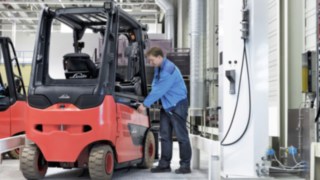
Sustainable Warehouse Greenprint
16 Feb 2023
Intralogistics specialists Linde Material Handling UK has published a new report: A Greenprint for Sustainable Warehousing, based on contributions from industry leaders and experts including the FMCG sector. Key findings reveal that:
- Proximity to road and rail freight networks, airports and sea terminals, access to labour and to a reliable electricity supply together provide an ideal starting point for greener intralogistics operations.
- There’s now a very big shift towards lithium-ion in electric forklifts away from acid-lead batteries, which is offering 20-30% increase in efficiency, energy savings and CO2 emission reductions.
- Hard questions need to be asked of suppliers and FMCG manufacturers about what to do with lithium-ion batteries. Whilst they have a long life in forklifts – five or seven years – a reuse market needs to be established.
- For manufacturers and outsourced logistics providers who cannot easily switch from internal combustion forklift vehicles, hydro-treated vegetable oil is very compatible with diesel trucks, offering greatly enhanced environmental performance.
- Reducing forklift speeds and limiting travel distances, as well as changing how and when vehicle batteries are recharged, all present sustainability and efficiency benefits.
- Smart planning through simulation of warehouse operations and innovative approaches to asset management support greater efficiency and better environmental performance.
- Solar energy offers significant opportunities to reduce the carbon footprint of warehouse operations through rooftop and ground-mounted installations as well as the introduction of solar carports on site.
- In the last year larger warehouse landlords have increasingly been introducing solar energy systems, given their potential, which opens up the opportunity of a renewable energy source to tenants on short leases.
Says Tracy Clarke, who is responsible for managing Linde Material Handling’s energy solutions: “Warehousing across the UK represents a considerable carbon footprint and means that the intralogistics environment has a crucial and considerable contribution to end-to-end sustainability across the supply chain in the FMCG sector. We wanted to shine a light on the best ways to enable the greening of the intralogistics leg of the supply chain by drawing on expert insights and perspectives which we have turned into a special ‘greenprint’ for carbon action.”
A copy of the Greenprint for Sustainable Warehousing is available at https://www.linde-mh.co.uk/en_uk/About-Linde/Webinars/
